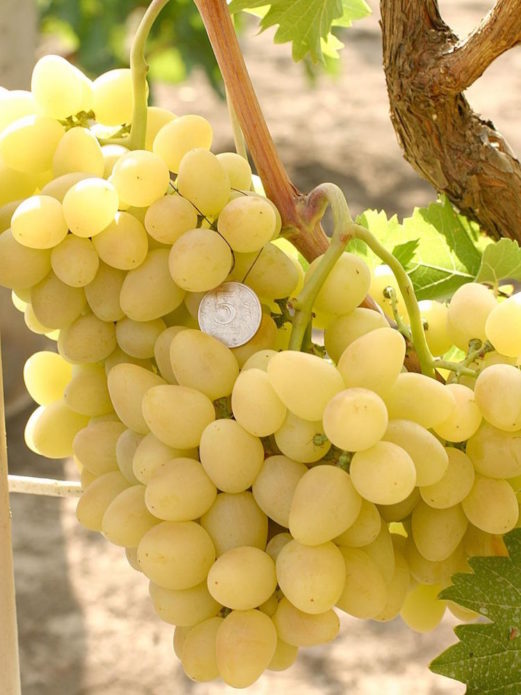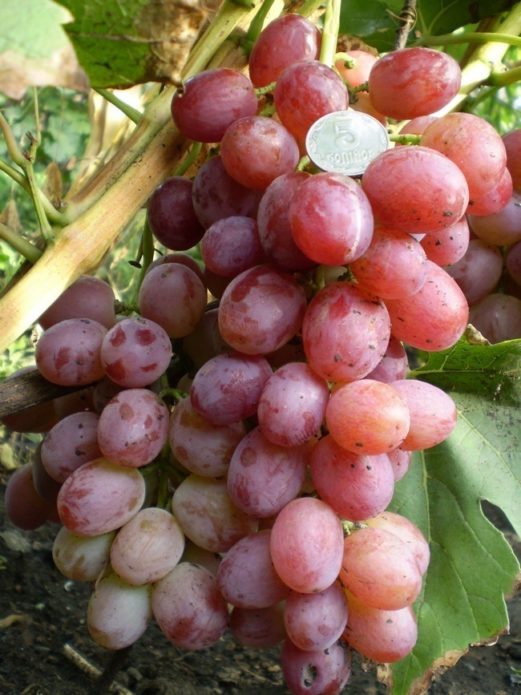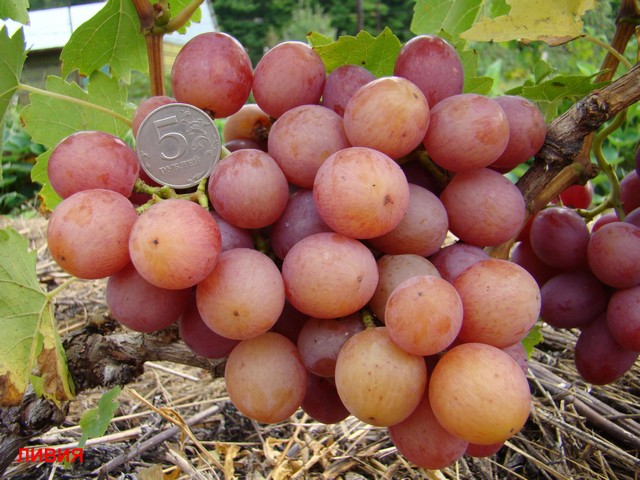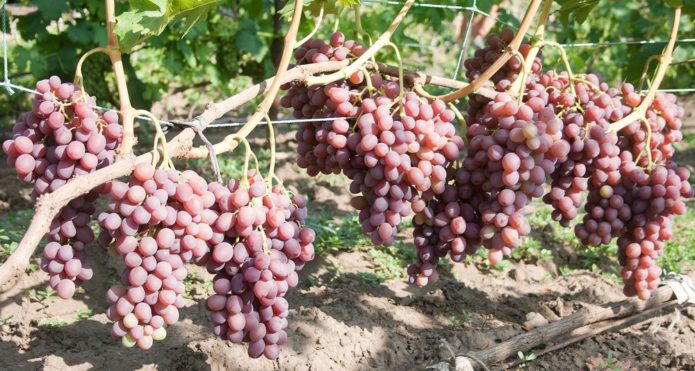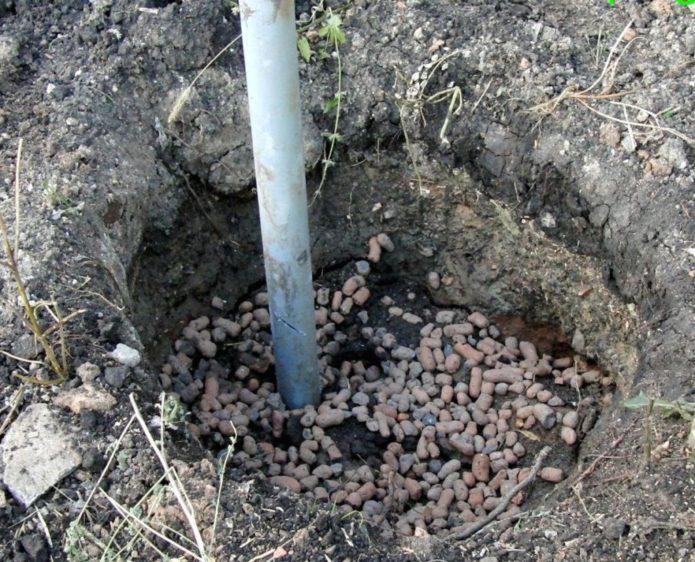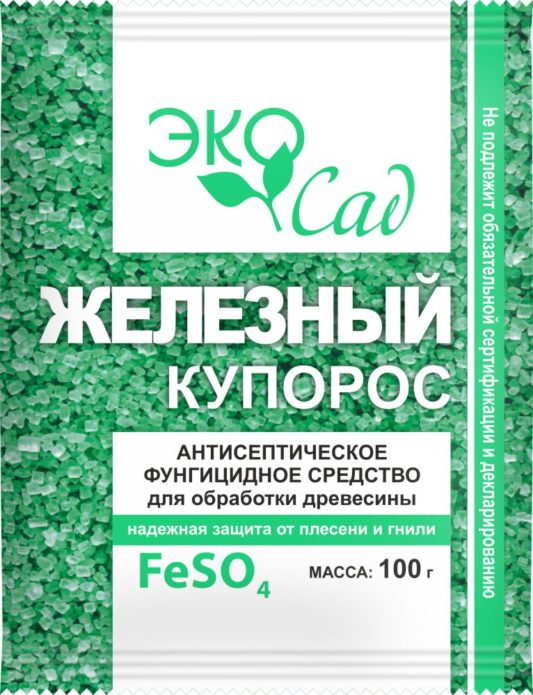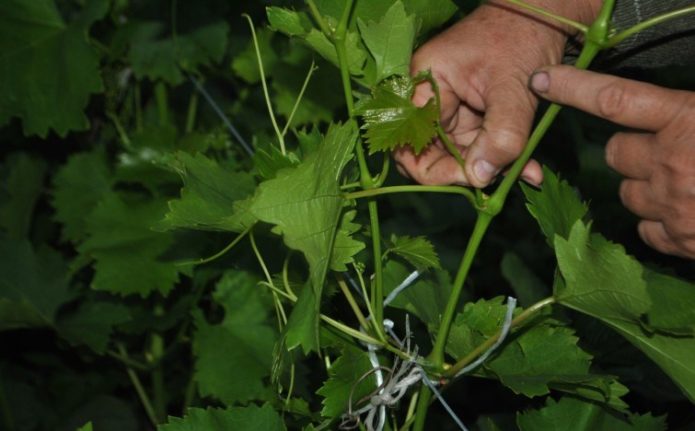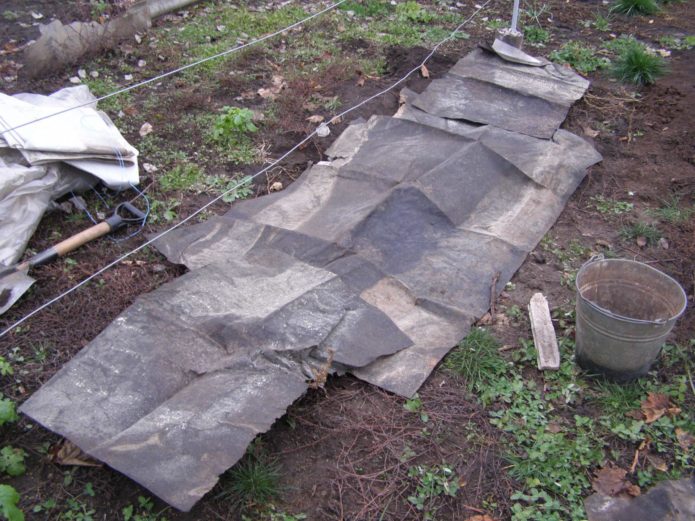Libya grapes are one of the most popular table grape varieties of Ukrainian selection. It is in high demand among both wine growers and berry lovers in the markets. Its shortcomings are overlapped by undoubted advantages, including ultra-early ripening, beautiful and tasty fruits, good yield.
Content
Breeding history and description of grapes Libya
A relatively new grape variety Libya was bred by the Ukrainian amateur breeder V.V. Zagorulko (Zaporozhye), who has nothing to do with agriculture by profession. The enthusiast graduated from the Faculty of Electronic Engineering of the Mechanical Engineering Institute in 1986, but became interested in viticulture in his youth, at the end of the 20th century. Many grape varieties were created by his hands, and more than a dozen have gained wide popularity.
V.V. Zagorulko strives to develop varieties that are distinguished by annual early fruiting, self-pollination, wonderful berry taste and good transportability. Libya grapes are obtained on the basis of the Flamingo and Arcadia varieties widespread in Russia. From the first, he almost completely took over the appearance of the berries, and from the second - the early ripening period. Libya has become a variety that the breeder himself considers one of his best products, he is very proud of it.
The popularity of the Arcadia variety is evidenced by the fact that it is known and successfully grown even in the most "grape" country - France, whose inhabitants are well versed in the qualities of grape berries:https://flowers.bigbadmole.com/en/yagody/vinograd/vinograd-arkadiya-opisanie-sorta-foto-otzyivyi.html
According to V.V. Zagorulko, Libya has surpassed all his expectations, in the markets this grape is sorted much earlier than other berries. It was entered into the State Register of Ukraine in 2011, and a year earlier it was patented in the country. The variety is also grown in many private and farm vineyards in Russia.
Libya grape bushes are vigorous, fruiting occurs in 2-3 years after planting or grafting. If you want to grow berries on not too large bushes, you can graft the variety on a small stock: with most of the known varieties, the accretion is good. Often grape grafting on a suitable variety resistant to the vagaries of the weather allows you to get even larger berries, and the yield increases at the same time. Lignified cuttings of Libya also take root well.
Young shoots of the variety are light green, not pubescent; during ripening they acquire a light brown color. The leaves are five-lobed, with a medium dissection. Shoots overloaded with harvest ripen on average by 75%, annual shoots without berries - completely. Frost resistance is relatively low - up to -21 ... -22 ° С, that is, it is not an undoubted advantage of the variety, at present a large number of more winter-hardy hybrid forms of grapes have been bred. Resistance to major diseases at the level of Arcadia is estimated at 3.0-3.5 points, but specifically to oidium is 3.5-4 points. The variety is considered unpretentious to care for.
Libya is one of the early or very early table varieties: the time from the beginning of the growing season to the ripening of berries is about 3.5 months. The flowers are bisexual; for a full-fledged set of berries, replanting bushes of other grapes is not required. The bunches are large, usually cylindro-conical, the berries in the bunches are not very dense. The mass of one bunch is just under 1 kg. There is practically no peeling: all berries are about the same size.
The fruits of Libya are large, weighing from 10 to 15 g. Their shape is variable: the berry can be either almost round or slightly oval or even ovoid. Due to uneven ripening, fruits of different colors are present on one brush, from yellowish to pink, but even at the slightest pinking they become edible. The color of the finally ripe berries is deep pink, with a purple tint. Each fruit contains up to 3 small seeds, the skin is soft, does not interfere with use.
The pulp is dense, juicy, very tasty, with a pronounced nutmeg aroma. The berries are well stored, the taste does not change for several weeks. Sugar content is very high - up to 24%, as a result of which the grapes are strongly affected by wasps. Moderate acidity: 5–6 g / l, with a lack of sunlight it can be slightly higher.
The bunches are stored for a long time without removal, the taste of the berries improves, the color is evened out. Despite the fact that after harvesting the fruits do not deteriorate for some time (in the refrigerator - up to a month), they react poorly to transportation, neat packaging and the absence of sharp shaking are required.
In general, the Libya grape by its properties is one of the best table varieties of very early ripening.
Grapes are able to grow on almost any soil, except that saline and waterlogged ones are categorically not suitable for it. But rocky lands and sandstones are ideal for him:https://flowers.bigbadmole.com/en/yagody/vinograd/kak-posadit-vinograd.html
Video: characteristic of grapes Libya
Features of planting grape varieties Libya and caring for him
Libya grapes can be recommended even for inexperienced gardeners, since it is not difficult to grow it. Both planting and the basic principles of care differ little from the agricultural technology of other early table varieties. Libya is a common covering grape with good frost resistance.
The ideal growing soil is nutrient-rich black soil, but the crop can grow in any soil. For planting grapes, you need to choose the sunniest area, closed from cold winds, especially the northern direction.
A tall house, a solid fence, mature fruit trees, etc. can serve as protection of the grapes from the winds.
Libya seeks to grow upward, towards the sun, but in order to form a high-quality harvest, the shoots will have to be placed, including horizontally, so you need to immediately provide for a strong trellis.
Libya can be planted by cutting, this is one of the easiest breeding methods. Often, the acquired stalk is grafted into a stem of another, more frost-resistant variety, getting good results from the grafting. When choosing a ready-made seedling, you need to pay attention to one with well-developed roots. In the south, grapes are planted in spring and autumn; in the middle lane, it is desirable to do this in April.
Landing procedure:
- The previous summer, you need to dig up the selected area, adding the most common fertilizers to it, thus preparing fertile soil.
- In the fall, you need to dig a planting hole. Its dimensions should be 70x70 cm or more.
- A layer of drainage (crushed stone or broken brick) should be placed on the bottom of the pit and a thick pipe should be laid there for watering the roots in the first few years. The bottom layer in the pit should be well fertilized fertile soil, the next layer should be soil without fertilizers. The grapes are planted deeply, but so that the roots are in clean soil, where there are no fertilizers.
- 1-2 buds are left on the surface, watered, mulched.
Care for Libya consists of watering, fertilizing, pruning, preventive spraying. Perhaps the most difficult thing is qualified pruning, the rest of the operations are familiar even to a novice gardener.
Watering is rarely needed, stagnant water does not lead to anything good. The greatest need for watering is during the growth of berries, and it is not worth watering it a month before harvesting. Excess water can cause Libya's berries to crack. Usually, sub-winter watering is also required, especially if the autumn is not too rainy.
It is generally recommended to feed with ash: annually bury 1-2 liters under the bush. After a year, early spring fertilization with humus, which is buried in small grooves, will not hurt. In addition, it is necessary to carry out foliar dressing by spraying the leaves. Before flowering and immediately after it, it is convenient to use weak solutions of mineral complex fertilizers, and then nitrogen is excluded from the formulation.
Libya has an average resistance to grape diseases, therefore, at a minimum, spraying with an iron sulfate solution is required, carried out in early spring. Along the green cone, that is, at the moment the buds begin to spread apart, you can treat with 1% Bordeaux liquid. Shortly before flowering, the vineyard is sprayed with Ridomil Gold.
Iron vitriol in the fight against diseases and pests in the vineyard:https://flowers.bigbadmole.com/en/yagody/vinograd/obrabotka-vinograda-zheleznyim-kuporosom.html
Spring pruning in Libya is dangerous: very early begins "crying", so in the spring it is necessary to remove only the obviously dead sections of the vine. In the summer, it is necessary to constantly break out excess green shoots and stepchildren while they are young. It is recommended to remove unnecessary clusters, leaving no more than 2 on each shoot. The main pruning is in the fall, before the bushes are sheltered for the winter. The variety requires short pruning of shoots, 2–6 eyes. No more than 45 eyes are left on the bush, and in total it is optimal to form 4 main sleeves.
Libya is very badly damaged by wasps and other flying insects, so you have to seriously fight with them. Sometimes a cover on a bush made of a transparent mesh reduces the affection, but traps should also be set: jars of honey infusion mixed with any insecticide. It is very time consuming to place each bunch in an individual gauze bag.
Before the onset of frost, the bush must be removed from the supports and the shoots must be spread on the ground so that it is convenient to cover them. There is no need to bury grapes in the ground, like old varieties. In regions with not too severe frosts, spruce branches of coniferous trees are used; in harsh climates, non-woven materials or pieces of roofing material can be added. In the case of a solid shelter, it is imperative to scatter rodent control preparations under it.
Advantages and disadvantages of the variety in comparison with similar
Libya is a valuable grape variety, it can be compared, first of all, with its parents: Flamingo and Arcadia. Despite the fact that Arcadia is confidently among the best world table varieties, the offspring did not shame her: he took all the best from her, and added the missing from the second parent. The undoubted advantages of Libya are:
- very early maturation;
- excellent presentation;
- wonderful nutmeg taste;
- stable and high yield;
- lack of peas: evenness of berries in a bunch;
- long shelf life for an early variety;
- good resistance to powdery mildew;
- ease of care;
- the possibility of propagation by cuttings or grafting;
- the presence of both female and male flowers: does not require pollinators.
However, experts pay attention to several very serious shortcomings, for example:
- uneven coloring of berries in bunches;
- poor resistance to gray rot;
- susceptibility to wasps;
- not too high, by modern standards, frost resistance.
But the noted disadvantages of the variety do not in the least diminish the merits, since most of them can be easily dealt with with some effort.
Variety reviews
We leave 30 bunches on it. Tried more last year, does not pull. It happens, as in Arcadia, if overloaded, clusters wither (3-4), however, without prejudice to the rest of the crop.
Here, in Volgograd, it has fully matured by about July 27-August 1. Hanged on a bush before leaving the site - until about September 25. Has not lost its taste and tasted good too. Now it still lies (this is my family's "fashion" to look at how they are stored, new varieties on my site).
Two bushes of Libya this year have given a full harvest. In early summer, the leaves showed signs of mildew. After processing Ridomil-Gold everything stabilized. There were no illnesses until the end of the season. The berries did not crack, they were beautifully colored, they were sweet, tasty. The sight of the bunches was impressive. All this was appreciated not only by home "tasters", but also by buyers in the market.
Video: a grower review of the Libya variety
Libya grapes are a worthy representative of the very early table grapes. It is not very suitable for growing in the northern regions, but in the southern regions and the central zone of Russia, caring for it does not present any particular problems. For its marketable qualities and excellent taste, Libya has earned respect both among specialists and among amateur winegrowers.
